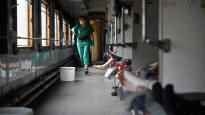The International Medical Association has two medical trains in Ukraine, one with an intensive care unit. In addition to medical assistance, the organization also trains and maps the material needs of Ukrainian hospitals.
Destroyed buildings, civilians with blast and fragmentation injuries, doctors and nurses working around the clock.
All this Cariant Rock saw Ukraine in a month – long mission that ended about a week ago.
The injuries to the patients were brutal in the eyes of the humanitarian doctor, and the threat to civilians was shocking.
– Most injuries are fragmentation and explosion injuries. They are difficult to see even for a cynical doctor.
Kallio is a specialist in anesthesia and intensive care and is a member of Doctors Without Borders.
He first toured hospitals in the Zhytomyr region west of Kiev, then in eastern Ukraine in the Dnipro and Donetsk region. There have been fierce fighting in eastern Ukraine since Russia launched a major offensive.
– The work was more or less the same: we went to the hospital, told us who we were and where we could help. We first asked what their needs are.
For some hospitals, the more fragmented may be a new situation
Humanitarian work in Ukraine differs from many other countries at war in that Ukraine has a high level of university education and a skilled staff.
The organization has an important role to play in helping where help is most needed. It can mean the supply of surgical supplies or training, for example, in the treatment of splinters.
– Some doctors already have a lot of experience with this. There may also be hospitals that did not treat such patients before the start of the war, Kallio says.
You can listen to Kallio’s experiences on ‘s News Podcast:
Medical trains are taking Ukrainians to safety
Of the two Doctors Without Borders medical trains in Ukraine, one is even equipped with an intensive care unit.
Inside the passenger train are beds, hospital beds, drip racks, monitors and a wide range of other care supplies.
According to Kallio, the medical train also aims to help those who have not been able to escape the war on their own. In addition to treating injuries, trains are transporting Ukrainians west to safety from fighting and bombing in eastern Ukraine.
In the Dnipro, he saw patients being picked up on a medical train. One of them was a young woman in her twenties who had lost both legs.
– He had a captivating smile and he was in a good mood. It became a good feeling that at least he could get to a safer place and life could go on there, but what kind of life. A life that hasn’t yet started terribly.
The determination and courage of the Ukrainian medical staff was also remembered. Kallio is ready to go back again if the opportunity arises.
– There are other wars and crises. We go where the need for help is. It is ultimately up to the organization and not me.
